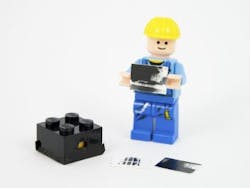Much of what we cover on Vision Systems Design is rather technical, or at least serious in nature. From time to time on the blog, I like to take a look at off-beat, fun, or interesting bits of news, such as sharks eating cameras attached to robots, or the innovative use of a digital cinema camera with a Microsoft Kinect to create a unique music video.
MORE ARTICLES
Worldwide Industrial Camera Directory
Will the machine vision market grow in 2015?
Vision Systems Design announces 2015 Innovators Awards program
So for this particular blog, I wanted to write about Legos. If you aren’t familiar, Legos, according to Wikipedia, consist of colorful interlocking plastic bricks and an accompanying array of gears, minifigures and various other parts. Kids use Legos to build objects like vehicles, buildings, and robots, all in the name of fun. But at the intersection of vision systems and Legos is Ryan Howerter, a graphic design student at Colorado State University who felt compelled to turn a Lego brick into a working pinhole camera.
Howerter, according to CNET, felt compelled to do so after hearing a story in his photography class about the Pinholo, a tiny functioning camera inside of a pine nut.
"Being a fan of Lego bricks, I had to carry this idea to its logical conclusion," he told CNET.
To do so, he hollowed out a Lego brick and placed photographic paper inside. His materials list includes the brick, the paper (or film), black tape, and a piece of brass shim stock in which you poke a tiny hole through. Also required is a tool to remove the brick’s central support and gear for developing photos. Using these materials, he exposed the photographic paper and processed it to create some tiny images of a tree on the Colorado State campus. The hardest part of the process, according to Howerter, was to not over or underexpose the paper or film.
While this is most definitely a “just for fun” type of story, it is encouraging to see people like Howerter thinking outside of the box while having some fun, when it comes to cameras and image processing. Perhaps he has a future in the industry!






